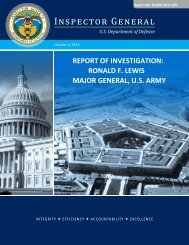Command Red Team
2gWzzvB
2gWzzvB
Create successful ePaper yourself
Turn your PDF publications into a flip-book with our unique Google optimized e-Paper software.
CHAPTER IV<br />
RED TEAM ACTIVITIES<br />
“One thing a person cannot do, no matter how rigorous his analysis or heroic<br />
his imagination, is to draw up a list of things that would never occur to him.”<br />
Thomas Schelling<br />
Nobel Prize Winner, 2005<br />
“Impossibility Theorem”<br />
1. Overview<br />
a. <strong>Red</strong> teams are general purpose decision support assets that can enhance problemsolving<br />
efforts in all functional areas, in all organizations, and at all echelons.<br />
b. <strong>Red</strong> teams employ a variety of tools to frame problems, challenge assumptions,<br />
analyze conditions, explore solutions, and support decision making. The most<br />
appropriate tools are listed in this chapter according to the area of effort they most<br />
frequently support, but these tools should be freely adapted to support any area of effort.<br />
To assist red teams, a full range of current tools, techniques, and best practices, is located<br />
on the UFMCS website at http://usacac.army.mil/organizations/ufmcs-redteaming/schedules-and-handbooks.<br />
The areas of effort are: decision support, critical<br />
review, role play, and vulnerability testing.<br />
c. While red teams can support decision making in all functional areas, they can be<br />
especially useful in those areas where complex variables must be considered, where<br />
precedents may not be applicable, and where the selected COA is likely to impact<br />
multiple aspects of the situation. <strong>Red</strong> teaming should be considered when addressing<br />
problem sets in the following functional areas:<br />
(1) Doctrine and tactics development.<br />
(2) Operational, campaign, contingency, and interagency planning.<br />
(3) Operational design and commander’s vision of the problem.<br />
(4) Exercise development and evaluation.<br />
(5) Force structure organization and development.<br />
(6) Assessments of systems and processes.<br />
(7) System test, evaluation, and acquisition.<br />
(8) Intelligence collection and analysis.<br />
IV-1



